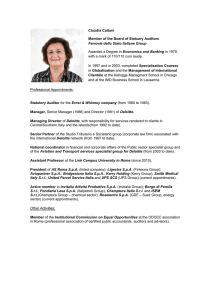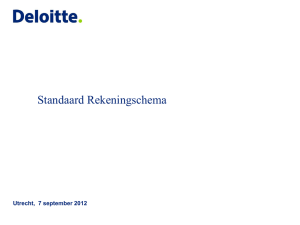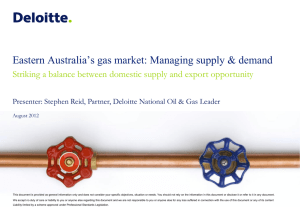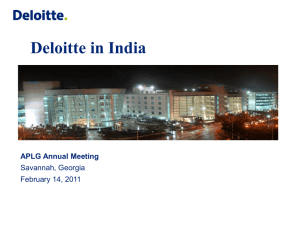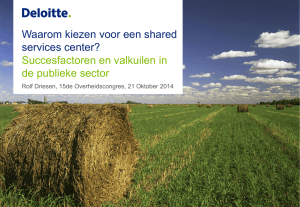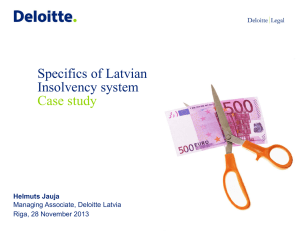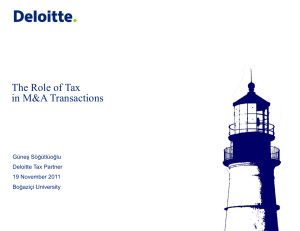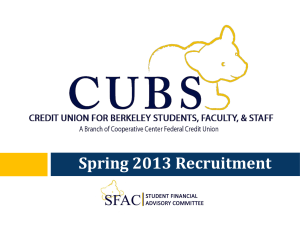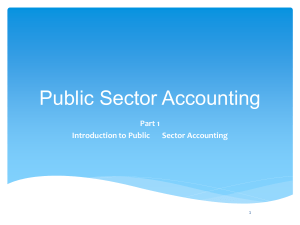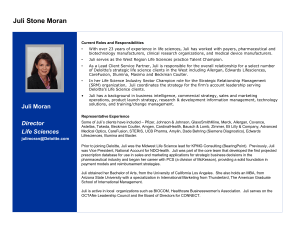A Brief History of Accounting - Official Site of Dharma Tintri Ediraras
advertisement
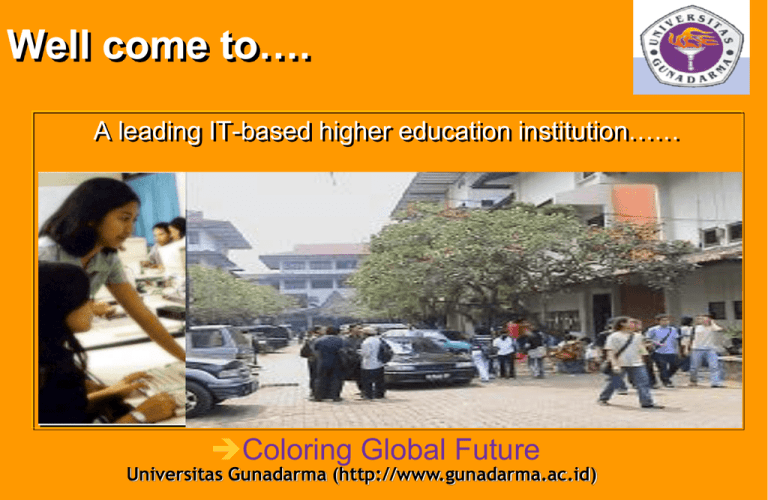
Well come to…. A leading IT-based higher education institution…… Coloring Global Future Universitas Gunadarma (http://www.gunadarma.ac.id) First Lecture A BRIEF HISTORY OF ACCOUNTING Dr. Dharma Tintri Ediraras, SE., Ak., MBA Auditorium D340 Margonda Campus Monday, 11th July 2010 Agendas of this morning… Overview of economics Learn more about accounting Accounting Carriers Who I am…… Yesterday Now Future... Name: Dharma Tintri Ediraras No Register Akuntan : D835 Education: (1) Padjadjaran University, Indonesia (2) Asean Institute of Technology, Thailand (3) Padjadjaran University, Indonesia Positions: (1) Head of Undergraduate Program in Accounting Gunadarma University (2) Senior Lecturer & Advisory at Gunadarma University: Faculty of Economics, Master of Management, Master of Information Sistem, Doctorate Program in Economics (3) Research Section of Accounting Educator Compartemen, Institute of Accountants Indonesia (4) Assesor of National Accreditation Body at Directorate of Higher Education, National Eduation Department of RI Others: (1) Junior Accountant at PT Kimia Pharma, 1985-1987 (2) Senior Accountant at KLM Airleines Indonesia, 1989 (3) Manajer, Athur Andersen certified Accounting Office, Bandung Branch, 1989 - 1990 (4) Temporer Counsultant at Internal Auditor Institute of Indonesia Chapter., 1994 - 1999 Activities Research Leader Model of strategic Planning Information System For SMEs (DP2M DIKTI, Diknas), 2006/7 Model of Letter Of Credit Document Management Via Intenet Technology, 2008 Model of ICT Based Political marketing for Major Election (Pilkada) In DKI Jakarta, 2011/13 Project Leader STAR SDP Project (Diknas-UG, Bappenas & ADB), 2006-2008 Education Program Coordinator Advanced IT Banking System Training Program, 1998/9 A training project for auditors within Bank of Indonesia ETC. http://staffsite.gunadarma.ac.id/dharmate email: dharmate@staff.gunadarma.c.id , dharmate@yahoo.com twitter.com/dte What is economics? The science of how scarce resources are allocated. The study of how individuals and societies use limited resources to satisfy unlimited wants. Fundamental economic problem: scarcity People always want more The question: Why can’t we have everything we want? The answer: Because our wants exceed our resources! Do you agree with that answer? Basic economic questions…. WHAT to produce We never have enough time to do everything we want to and there are no enough resources in the economy to produce all the goods and services societies desires. So, we have to decide WHAT we want most, sacrificing less desired activities and goods. HOW to produce There are numerous ways of teaching a course. Once or twice a week? In the morning, at noon, in the afternoon, or in the evening? At an auditorium, a class, or a laboratory? The key is HOW to find an optimal way of teaching. FOR WHOM to produce After having made a cake, we have to slice it. The question is should everyone get an equal size? So, it deals with distribution Market……. A traditional or basic definition: any place where goods are bought and sold. Participants: individual consumers (more than 200 millions); business firms; government agencies; and foreigners. Market…….interactions FOREIGNERS PRODUCT MARKET Goods & services are supplied Goods & services are demanded CONSU MERS BUSINESS FIRMS GOVERNMENTS Factors of production are supplied Factors of production are demanded FACTOR MARKET FOREIGNERS Market transactions… demand and supply Demand The willingness and ability to buy a range of quantities of a good at a range of prices, during a given time period. Ceteris paribus. Demand is one half of the market exchange process; the other is supply. This demand side of the market draws inspiration from the unlimited wants and needs dimension of the scarcity problem. People desire the goods and services that satisfy their wants and needs. This is the ultimate source of demand. Demand Determinants of demand price of its own income tastes number and price of substitute goods number and price of complementary goods income distribution of income expectations Movements along and shifts in the demand curve An increase in demand Price P D0 O Q0 Q1 Quantity D1 Supply The willingness and ability to sell a range of quantities of a good at a range of prices, during a given time period. Supply is one half of the market exchange process; the other is demand. This supply side of the market is directly connected to the limited resources dimension of the scarcity problem. Folks who have ownership and control over resources (labor, capital, land, and entrepreneurship) use them to produce the goods and services that satisfy other's wants and needs. Ownership and control of resources is the ultimate source of supply. Supply Relationship between supply and price – as price rises, firms supply more • it is worth incurring the extra unit costs • they switch from less profitable goods • in the long run, new firms will be encouraged to enter the market The supply curve Supply Determinants of supply price costs of production profitability of alternative products profitability of goods in joint supply nature and other random shocks aims of producers expectations of producers Movements along and shifts in the supply curve Shifts in the supply curve P S2 Decrease O S0 S1 Increase Q ACCOUNTING HISTORY Diawali dengan pengetahuan tata buku Bonzaken (Bon A/B) yang dibawa Belanda (Dipelopori oleh Unpad & Undip), sebagai suatu “persamaan pembukuan berpasangan, debet = credit”, kontribusi dari Luca Pacioli* (1494, Summa de Arithmetica Geometrica, Proportioni et Proportionalita), sekaligus sahabat dari Leornardo Da Vinci yang membuatkan ilustrasi buku tersebut, “Da Vinci Code”. * Rahib & Misi ke China menggunakan Abacus ACCOUNTING HISTORY Kemudian masuk pengetahuan akuntansi dari Amerika hingga sekarang (Dipelopori oleh Barkeley Univ Mafia UI, UGM). Hakekat akuntansi dapat digambarkan dalam berbagai definisi seni penyajian laporan keuangan, ideology untuk melegitimasi aturan-aturan social, ekonomi dan politik yang berlaku saat ini, bahasa bisnis untuk media komunikasi antar stakeholder, sistem informasi, komoditas, mitos dan perumpamaan maupun alasan logis, serta sebagai eksperimen dan distorsi ( Wolk, Francis & Tearney, 1992). ACCOUNTING EDUACTION Pra 2000 Lulusan UI, Unpad, UGM, Undip, Unair & Usu memiliki gelar SE., Ak.(Diknas & Depkeu) Lulusan selain diatas (PTN maupun PTS) bergelar SE, selanjutnya harus melalui ujian negara akuntansi (UNA) Dasar & Lanjut di PPA PTN untuk mendapat gelar Ak. Tahun 2000 dst Semua lulusan dari PT mendapat gelar SE, selanjutnya harus mengikuti PPAK suatu PT atau di IAI untuk mendapatkan gelar “BAP” bersertifikat akuntan publik. Accounting is a body of Knowledge Atap: Users Dinding: 5 lapis Harta/aktiva, Hutang Modal, Pendapatan Beban Pondasi: 12 Prinsip / Standar / Asas Akuntansi Ilutration Going Concern & Business Entity Principles Accounting Equation (Lucca Facioli) Assets = Capital Assets = Liabilities + Owner Equities Harta = Utang + Modal pemilik Business Interuption / Mismanagement Bancrupt (Legal) H – U = M (True) H – M = U (False) Ilutration Going Concern & Business Entity Principles Accounting Equation (Lucca Facioli) Assets = Capital Assets = Liabilities + Owner Equities Harta = Utang + Modal pemilik Business Interuption / Mismanagement Bancrupt (Legal) H – U = M (True) H – M = U (False) Accounting Fields Financial Accounting Basic/Principle Intermediate Advanced Theory Acc Forensic Management Accounting Cost Acc Basic Mgt Acc Advanced Mgt Acc ABC/ABM BSC, etc. Auditing: Financial, Management, Fraud, Comphrehensif AIS (& Business inteligent: ERP, SAP, CRM, etc), Tax. Accounting Scope Double Entry Micro - Commercial Accounting (Business entity) - Profitary entity (Private sectors) - Fund Accounting / Not to Profit entity - Government Acc (Government & Public sectors) - Fiduciary Acc (organisasi nirlaba) - Syahriah acc (Islamic Acc) Macro - Socio Economic Accounting - Balance of Payment Cross Border International Accounting Accounting is a Business language for Business entity & Stake holders Top Middle Lower Others Management Creditors Creditors Business Entity Suppliers/ Vendors Buyers/ Customers Government Type of Information Information Nonquantitative Information Quantitative Information Accounting Information Operating Information Financial Accounting Nonaccounting Information Management Accounting Tax Accountng Dokumen Sumber (Faktur-Faktur Transaksi) Jurnal Buku Harian Posting Buku Besar Jurnal: Penyesuaian Penutup Pembalik Neraca Lajur Ringkas Siklus Akuntansi Keuangan Buku Pembantu Laporan Keuangan (Neraca, Lap R/L, Lap Arus Kas, dll) Gambar 5 Generate reports Collect data Managerial decision makers Process data Data base Apply decision models Dokumen Dokumen Dasar Dasar Analisis dan perekaman transaksi Penjurnalan Jurnal Jurnal Posting Buku Buku Besar Besar Rekonsiliasi Penyesuaian Neraca Neraca Saldo Saldo Neraca Saldo Neraca Saldo Setelah Setelah Penyesuaian Penyesuaian Pelaporan Laporan Laporan Keuangan Keuangan Laporan Keuangan Fiskal Rekonsiliasi Penyusunan Laporan Keuangan Fiskal PERUSAHAAN PERSEROAN (PERSERO) PT ANEKA TAMBANG Tbk DAN ANAK PERUSAHAAN LAPORAN LABA RUGI KONSOLIDASIAN Tahun yang Berakhir pada Tanggal 31 Desember 2007 Dengan Angka Perbandingan untuk Tahun 2006 (Disajikan dalam ribuan rupiah, kecuali laba bersih per saham) PERUSAHAAN PERSEROAN (PERSERO) PT ANEKA TAMBANG Tbk DAN ANAK PERUSAHAAN LAPORAN LABA RUGI KONSOLIDASIAN Tahun yang Berakhir pada Tanggal 31 Desember 2007 Dengan Angka Perbandingan untuk Tahun 2006 (Disajikan dalam ribuan rupiah, kecuali laba bersih per saham) LAPORAN KEUANGAN TALENTA Comp NERACA Per 28 Pebruari 2002 AKTIVA (Rp) AKTIVA LANCAR Kas Piutang Usaha 63.650.000 3.000.000 Supplies Bengkel 1.000.000 Supplies Kantor Total Aktiva Lancar AKTIVA TETAP Bangunan Ak. Dep. Bangunan Mesin Ak. Dep. Mesin Peralatan Bengkel Ak. Dep. Prt Bengkel Total Aktiva Tetap Total Aktiva PASIVA (Rp) 500.000 68.150.000 90.000.000 1.500.000 45.000.000 750.000 50.000.000 1.666.667 88.500.000 HUTANG Hutang Usaha Pdt Diterima Dimuka Total Hutang 42.000.000 MODAL Modal Tanti Modal Lenny Modal Tanto 90.000.000 75.000.000 50.000.000 Laba (Rugi) Sekarang Total Modal 32.000.000 10.000.000 (7.766.667) 207.233.333 44.250.000 48.333.333 181.083.333 249.233.333 Total Pasiva 249.233.333 TA LENTA Com p Laporan Laba Rugi Periode 10 Jan u ari sam pai den gan 28 Pebru ari 2002 KETERA NGA N PEN DAPATAN Pendapatan Softw are Pendapatan Serv ice Pendapatan Training JUMLA H (Rp) 1.000.000 1.000.000 3.000.000 Total Pendapatan 5.000.000 BIAYA OPERASION AL Gaji Supplies Bengkel 3.000.000 4.000.000 Supplies Kantor 1.500.000 Biaya Telepon Biaya Listrik Depresiasi Bangunan 200.000 150.000 1.500.000 Depresiasi M esin Depresiasi Peralatan Bengkel Total Biaya Laba (Rugi) Operasi 750.000 1.666.667 12.766.667 (7.766.667) Paket Program Akuntansi Asing (Import) : Value Plus ACCPAC DacEasy Accounting Instance Accounting MYOB Accounting Master Accounting Pacioli Peachtree Quick Book Pro Quick Deluxe Simple Bussines Accounting USB Accounting Package SAP dll Lokal : Zahir Computer AbiPro Accurate 2000 AccountPro dll Economic Era & New Business Models Economic Era: - Stone Barter Exchange - Classic Traditional - Modern Merchants & Banking (Plastic money, card, debit) - Digital Virtual market (Amazon.com, ect) Business – Retail & trading – Manufacturing – Service industry – Media Computer Aided Manufacturing New [smart?] Devices E-commerce ACCOUNTING CARIERS Profesi • Akuntan Publik • Analist Sistem Informasi Akuntansi • Akuntan Manajemen • Akuntan Pemerintahan (Pajak) • Akuntan Pendidik • Manajer Keuangan • Auditor Forensik • Corporate Secretary • Wirausaha Di berbagai bidang industri/usaha dan jenis organisasi Pasar Kerja I. Lokal (Dalam Negeri) • Kantor Akuntan Publik (KAP) - DKI Jakarta : 241 KAP & 164 KAP di BEJ - Diluar DKI Jakarta : 441 KAP - Rata-rata dibutuhkan 1000 Akuntan / Tahun. • Akuntan Manajemen dan Controllership - Rata-rata dibutuhkan 1000 Akuntan / Tahun • Akuntan Pemerintahan (Pajak) / Comptoller - Depkeu : Badan Pemeriksa Keuangan dan Pembangunan (BPKP) dan Badan Pemeriksa Keuangan (BPK), Bawasda di tiap-tiap provinsi di Indonesia - KPK dan BI, etc Pasar Kerja - BI dan Dep. Lainnya - Rata-rata dibutuhkan > 2.000 / Tahun • Akuntan Pendidik - Di PTN maupun di PTS • Manajer Keuangan - Rata-rata dibutuhkan > 2.000 / Tahun • Corporate Secretary - Rata-rata dibutuhkan 100 / Tahun • Analist SIA - Rata-rata dibutuhkan 2.000 analist / Tahun (Sumber: IAI, Depkeu, Depnaker & Deperindag; 2008) Pasar Kerja II. Internasional (Luar Negeri) - Arab Saudi & Timur Tengah, Rata-rata 2000 / tahun - Singapore, Rata-rata 2000 / tahun - Uni Eropa, Rata-rata 5000 / tahun - USA, Rata-rata 10.000 / tahun - Jepang, Hongkong, dll. Rata-rata 5000 / tahun (Sumber: World Bank, Ford Foundation, JICA, EU; 2008) DESKRIPSI KARIR S1 AKUNTANSI NO PROFESI BIDANG PEKERJAAN 1 Akuntan Pendidik Dosen/Periset 2 Akuntan Publik Auditor Eksternal/Publik Auditor Pemerintah/Comtroller (Internal & Eksternal) 3 Akuntan Pemerintah & Pajak Pemeriksa pajak Internal auditor/Controller Manajer keuangan/investasi/manajemen risiko 4 Akuntan Manajemen (Perusahaan) Staf akuntansi dan pajak Analyst Keuangan & Kredit/Pembiayaan 5 Analyst Analyist Sistem Inf ormasi (Akuntansi) Auditor SIA/Teknologi Inf ormasi/TSI Auditor Forensik Auditor Lingkungan (Amdal) 6 Auditor Specialist Project Due Dilegent Corporate Secretary Counsultant Quality Control Jurnalis Entreprener/Wirasw asta Administrasi 7 KOMPETENSI& Skill ORGANISASI/INSTITUSI Akuntansi Plus English Komputer Statistik/Metode Riset jenjang Institusi Pendidikan & Lembaga Riset Teori Akuntansi √ MS office(Words, excell. Access), Internet, SPSS/SEM √ S1 Big 5 KAP & MK Akuntansi Keuangan, SIA & Auditing √ MS Office, SAP, ACL, GAS, IDEA, Internet √ S1 BPK & BPKP Akuntansi Dana/Sektor Publik √ MS Office, Value +, GAS, Internet S1 Lembaga Pemerintah (Departemen & Non Dep, Bappenas) Budget, Auditng √ MS Office, SAP, Value +, DEA, GL, MRP, CAD/CAM S1 Akuntansi Manajemen/Biaya √ ERP, CNC, Internet s1&D3 Budgeting, finance √ MS Office, SAP, ACL, GAS, IDEA, Internet √ D3 √ MS Office, SAP, ACL, GAS, IDEA, Internet √ D3 √ S1 BUMN, Perusahaan swasta, Organisasi Nirlaba Bank/Asuransi, Modal ventura, dll), Bursa efek Akuntansi keuangan & Finance √ MS Office, Internet Divisi SI/TI/TSI setiap jenis institusi Sistem informasi akuntansi (SIA) √ MS Office, SAP, Internet & Jarkom S1 KAP bidang TI (Accentura, Auditindo, dll) SIA & Audit TSI √ MS Office, SAP, ACL, GAS,Internet & Jarkom S1 KAP, Kepolisian, Mahkamah Agung Audit Fraud & Forensic, Hukum/UU √ MS Office, Internet & Jarkom S1 LSM, KAP, World Bank, Organisasi pemerintah, ADB Akuntansi hijau/lingkungan & UU √ MS Office & Internet S1 Idem Akun Sosial ek. & Hukum/UU √ Idem S1 Perusahaan yang sudah Tbk (Go public) Ak., Teori Organisasi, UU& Komunikasi Bisnis √ Idem S1 Konsultan swasta, Staff ahli di organisasi pemerintah Akuntansi & Kebijakan publik √ MS Office, Internet √ s1&D3 Perusahaan swasta, Superyor/SGS International Manajemen produksi/mutu √ MRP, CAM, SPSS/SAS/Lisrell √ s1&D3 Perusahaan media pers Akuntansi/ riset akuntansi & komunikasi bisnis √ MS Office, Pagemaker, CAD & Internet S1 Pemilik dan pengelola perusahaan sendiri Akuntansi & kewirausahaan √ MS Office & Internet s1&D3 di Setiap jenis institusi/organisasi Akuntansi keuangan, akuntansi biaya & pajak √ Idem D3 organisasi politik Akuntansi & sospol √ Idem S1 ABRI dan POLRI Akuntansi Manajemen strategis √ Idem D3 BIG FIVE Accountant Office in the world http://www.kpmg.com “K” stands for Klynveld. Piet Klynveld was the founder of the Dutch accounting firm Klynveld Kraayenhof & Co., now KPMG in the Netherlands which was founded in 1917. In 1979 Klynveld joined forces with Deutsche Treuhand-Gesellschaft and the international professional firm McLintock Main Lafrentz to form Klynveld Main Goerdeler (KMG). “P” is for Peat. William Barclay Peat founded the accounting firm William Barclay Peat & Co. in London in 1870. “M” stands for Marwick. James Marwick founded the accounting firm Marwick Mitchell & Co. with Roger Mitchell in New York City in 1897. In 1911 William Barclay Peat & Co. and Marwick Mitchell & Co. joined forces to form Peat Marwick Mitchell & Co. later to become Peat Marwick International (PMI). “G” is for Goerdeler. Dr. Reinhard Goerdeler was for many years chairman of Deutsche Treuhand-Gesellschaft and later chairman of KMG. He is credited with laying much of the groundwork for the KPMG merger. In 1987 PMI and KMG embarked upon the accounting profession's first mega-merger and formed KPMG. BIG FIVE Accountant Office in the world http://www.ey.com Two people. One vision. It has taken the bold leadership and countless contributions of people around the world to form the leading global organization Ernst & Young is today. Our roots go back to the 19th century and our founders Arthur Young (1863-1948) and Alwin C Ernst (1881-1948). Arthur Young was born in Glasgow, Scotland. He graduated in law, but became interested in banking and investment. In 1890, he moved to the US to pursue his career in accounting. In 1906, he formed an accounting firm, Arthur Young & Company, with his brother Stanley. Alwin C Ernst was born in Cleveland, USA. After leaving school he worked as a bookkeeper. Then, in 1903, he and his brother Theodore started Ernst & Ernst, a small public accounting firm. Both Arthur Young and AC Ernst were innovators and appreciated the importance of quality in their work. Ernst pioneered the idea that accounting information could be used to make business decisions and make a difference to clients’ organizations. He inspired his people to deliver better service to clients. Young also positioned himself as a business advisor as much as an accountant. In 1920, Ernst & Ernst’s operating philosophy stated: “The success of Ernst & Ernst depends wholly upon the character, ability and industry of the men and women who make up the organization.” Young supported the development of professionals. In the 1920s he originated a staff school and, in the 1930s, the firm was the first to recruit from university campuses, also quick to enter the global marketplace. As early as 1924, they allied with prominent British firms: Young with Broads Paterson & Co and Ernst with Whinney Smith & Whinney. These alliances were the first of many for both firms, which opened offices around the world to service their international clients. AC Ernst and Arthur Young never met in life, but died within days of each other in 1948. However their philosophies lived on and, in 1989, were brought together when the firms they started combined to create Ernst & Young. The new organization quickly positioned itself on the leading edge of rapid globalization, new business technologies and continuous business change. AC Ernst and Arthur Young would surely be proud of the result — a global organization of 130,000 people sharing their ideals and passion to help clients improve their businesses around the globe. BIG FIVE Accountant Office in the world htt/www.deloitte.com Deloitte, Touch & Tohmatsu History of Deloitte It has been more than 150 years since William Welch Deloitte opened his own accountancy office across the street from Bankruptcy Court on Basinghall Street in London. Learn all about the history of Deloitte from the timeline below:1800 – 1833 At the age of 15, William Welch Deloitte becomes an assistant to the Official Assignee at the Bankruptcy Court in the City of London. This was the ideal apprenticeship at that time for a young man with an interest in the rapidly developing field of public accounting. 1845 Deloitte opens his own accountancy office opposite the Bankruptcy Court on Basinghall Street, London. 1849 In connection with the accounts of the Great Western Railway, W.W. Deloitte becomes the first person ever appointed as an independent auditor. Deloitte makes his reputation in particular through his work in the railroad industry — the "Web" of its day. During the 1850s and 1860s, he develops the system for keeping railway accounts, subsequently adopted as the industry standard, that protected investors from mismanagement of funds. He also develops a system of account-keeping for hotels that was universally adopted by large hotels in Great Britain and overseas. 1854 Royal Charter is granted to the Society of Accountants in Edinburgh, the first organized body of public accountants in the world. Among its founders was Alexander Thomas Niven, under whose tutelage George A. Touche would qualify as an accountant in Edinburgh 29 years later, before setting off for London to practice his profession. 1857 Deloitte accepts his first partner, Thomas Greenwood, who contributed £800 in capital. The firm becomes known as Deloitte & Greenwood. 1867 The Railway Companies Act lays down the auditor's duties and responsibilities. A statutory form of railway accounts was prescribed in 1868, and it is believed that Deloitte played a major part in designing the form and contents of such accounts — probably the first prescribed form of accounts in the modern sense. 1869 Admission to the partnership (at age 24) of John George Griffith, who exercised a major influence on the growth of the firm until his retirement in 1902. For this entire period, the firm is known as Deloitte, Dever, Griffiths & Co. 1880 Royal Charter issued incorporating the Institute of Chartered Accountants in England and Wales, with W.W. Deloitte, Henry Dever, and John Griffiths among the founding members. Philip S. Ross co-founds North America's first accounting society. 1880 First overseas Deloitte office opens in New York. Branches of this New York outpost are subsequently established in Cincinnati (1905), Chicago and Montreal (1912), Boston (1930), and Los Angeles (1945). 1893 Charles Waldo Haskins and Elijah Watt Sells meet in Washington, D.C. while working for the Dockery Commission of the U.S. Congress, which was undertaking the first comprehensive revision of the federal government's accounting practices since the time of George Washington. Two years later, they form a partnership — Haskins & Sells — based in New York City. 1897 Retirement of William Welch Deloitte. 1898 George Touche establishes his own firm in London. 1900 George Touche and John Ballantine Niven form Touche, Niven & Co. in New York. At that time, there were fewer than 500 certified public accountants in the U.S. Staff complement of Deloitte reaches 80 persons. Fees that year total £41,193. 1901 Haskins & Sells opens first regional office in Chicago and first overseas office in London. 1902 For the first time, a "lady typist" (sic) is engaged by the London office of Deloitte. 1905 Deloitte, Dever, Griffiths & Co. becomes Deloitte, Plender, Griffiths & Company. In the Hughes insurance investigation, which rocked the financial world and led to comprehensive revisions in the accounting methods of life insurance companies, Deloitte's New York office collaborates for the first time with the firm of Haskins & Sells. 1911 Firm of George A. Touche & Co. is established in Canada. 1917 George Touche is knighted by George V. Three years later, he is made a baronet of the United Kingdom. 1925 Two of our U.K. and U.S. predecessor practices form a co-partnership in several countries under the name Deloitte, Plender, Haskins & Sells. 1933 Congressional testimony by Haskins & Sells Managing Partner Arthur Hazleton Carter is instrumental in promoting the establishment of the SEC, as well as the requirement that public accountants audit the financial statements of all publicly traded companies. 1947 George Bailey & Co. is formed. Merges with Allen R. Smart & Co. and Touche, Niven & Co. to become Touche, Niven, Bailey & Smart. The first partners' meeting, held in Highland Park, Illinois, is attended by the firm's 33 partners. Net service revenues for the first year are US$3.6 million. 1952 Nobuzo Tohmatsu qualifies as a certified public accountant in Japan and becomes a partner in a foreign-affiliated accounting firm. 1952 Agreement reached to merge the businesses of Deloitte, Plender, Griffiths & Company and Haskins & Sells in the U.S., under the name Deloitte Haskins & Sells. 1960 Touche, Niven, Bailey & Smart merges with George Touche & Co. (Britain) and Ross, Touche & Co. (Canada) to form Touche, Ross, Bailey & Smart. 1961 Issuance of American Depositary Receipts in New York by Sony and Toshiba — the first Japanese companies to sell their securities in the U.S. 1965 Fraudulent bankruptcy of the Sanyo Special Steel Company leads to changes in Japan's Certified Public Accountant Law to provide for the formation of audit corporations similar to accounting partnerships in the U.S. and elsewhere. 1968 Under the leadership of Nobuzo Tohmatsu, Founding Partner, Tohmatsu Awoki & Co. (later Tohmatsu & Co.) starts operations with 10 partners and staff in Tokyo and smaller, loosely affiliated practices in four other Japanese cities. By 1989, the firm has 800 people in its Tokyo office alone, and a network of other offices throughout Japan, as well as Japanese professionals on assignment in Touche Ross offices around the world. 1969 Adoption of the name Touche Ross & Co., at the conclusion of a decade during which mergers were completed with more than 50 other firms in the U.S. and formal associations created with national firms in 55 countries. 1972 Touche Ross Chairman Robert Trueblood chairs a committee that leads to the establishment of the Financial Accounting Standards Board — the FASB. 1975 Formal agreement is signed by which Tohmatsu Awoki & Co. become part of the Touche Ross International network. 1978 The name Deloitte Haskins & Sells is adopted. 1985 Creation of the Office of the Chairman Program (now the Global Strategic Clients Program). 1990 Merger that creates Deloitte & Touche. 1993 International firm is named Deloitte Touche Tohmatsu. 1996 Deloitte & Touche Eastern Europe divided into two organizations — Deloitte & Touche Central Europe and Deloitte & Touche CIS. 1997 Deloitte & Touche Central America is established. 2000 Deloitte Touche Tohmatsu became a founding member of the United Nations Global Compact, which seeks to promote responsible global citizenship by advancing universal values in business operations around the world. 2002 Deloitte Touche Tohmatsu’s global revenues were US$12.5 billion. 2003 A decision to not separate Deloitte Consulting allows Deloitte Touche Tohmatsu to maintain its wide and deep range of multidisciplinary capabilities. 2003 On June 1, William G. Parrett is named Chief Executive Officer of Deloitte Touche Tohmatsu. Parrett joined the organization in 1967, and became a partner in 1977. 2003 On October 1, Deloitte Touche Tohmatsu records its 10th consecutive year of annual growth, with combined worldwide revenues from its member firms totaling US$15.1 billion. Additionally, the global organization announces the launch of the new brand name “Deloitte.” The change means that the firms known in various national and global markets as Deloitte Touche Tohmatsu and Deloitte & Touche, while retaining their local legal names, will now be known by the brand “Deloitte.” 2005 On August 29, William Parrett, CEO Deloitte Touche Tohmatsu, announces the name of a strengthened Korean Deloitte member firm—Deloitte Anjin LLC, the result of a transaction between Deloitte Hana and Anjin LLC. 2005 On September 1, Deloitte Touche Tohmatsu China merges with Pan-China Schinda, the second merger in the Mainland that year following a deal with Beijing Pan-China CPA Ltd. 2005 On December 19, Deloitte Touche Tohmatsu records its 12th consecutive year of annual growth, with combined worldwide revenues from its member firms totaling US$18.2 billion, a 10.9 percent increase over 2004 revenues of US16.4 billion. 2006 Deloitte Touche Tohmatsu announces aggregate revenues of more than US$20 billion in the fiscal year ending 31 May 2006, an increase of 10 percent over 2005. It is the fourth consecutive year of double-digit revenue growth and the 13th consecutive year of continued growth. 2007 On June 1, James H. Quigley is named Chief Executive Officer of Deloitte Touche Tohmatsu, succeeding William G. Parrett. In addition, John P. Connolly is named the new Chairman of the Board of DTT, succeeding Piet Hoogendoorn. 2007 Deloitte Touche Tohmatsu announces aggregate revenues of US$23.1 billion in the fiscal year ending 31 May 2007, an increase of 15.5 percent over 2006. It is the fifth consecutive year of double-digit revenue growth and the 14th consecutive year of continued growth. BIG FIVE Accountant Office in the world http://www.pwc.com pricewater house & cooper http://www.andersen.com--> Supreme court USA Certified Public Accounting Partnership Independent Auditor Partner Manager Head Manager Supervisor Akuntan Senior 1 Senior 2 Junior Junior Junior Financial Carrier Board of Directors Chairman of the Board and Chief Executive Officer (CEO) President and Chief Operating Officer (COO) Vice President and Chief Financial Officer (CFO) Treasurer Controller Cash Manager Credit Manager Tax Manager Cost Accounting Capital Expenditures Financial Planning Financial Accounting Data Processing Current Issues: Getting connected / virtual free market Etika Pertanyaan provokatif yang mendasar: “Apa para akuntan telah bekerja tidak saja dengan kepala, tetapi juga dnegan hati? Apakah pisau kompetensi akuntansi yang dimiliki akuntan dipergunakan untuk membedah pasien yang sakit dan ia hanya sembuh oleh pisau akuntan? Apakah akuntan bekerja sebagai seorang ahli akuntansi saja, atau sekaligus sebagai manusia yang berjalan dengan Ketaqwaan Illahi, kemampuannya digunakan setinggi-tingginya untuk memuliakanNYA?. Pertanyaan ini dipicu oleh hebohnya kasus jagat akuntansi yaitu creative accounting yang bertendensi white colar crime berupa skandal perusahaan besar, seperti Enron, Global crossing, Xerox, sampai WorldCom, di Negara paling maju SAK nya, USA. DSAK dan Bapepam sangat kompeten untuk memberi masukan kepada IASB, bahwa kitab suci seperti Al-qur’an atau pemeo dapat juga dijadikan kerangka dasar penyusunan SAK (Ediraras, 2004). Current Issues: Getting connected / virtual free market Current Issues: Getting connected / virtual free market Convergency Accounting Standard Triple Entry Elements of TBL Reporting Real Time / Electronic Auditing So It’s a must to think in english not only speak, To enhance our knowledge & skill continues, And be carefull with your heart and use it. Dr = Cr Dunia = Akherat Joint w/ Ikatan Mhs Akuntansi, AISEC, dll Watch movie: Wall street – black Monday Children of silk road – economic scarcity; Conspiracy of fools – enron scandal; Good will hunting & Crouching tiger hidden dragon – motivation. Reading Book: Buku Pedoman UG mhs baru, Rich dad rich son, money Talk, etc Misalnya surat Al Baqarah 282 dapat ditafsirkan bahwa “setiap umat yang beriman yang bermuamalah, dalam berjual beli, utang piutang, sewa menyewa dan sebagainya, hendaknya ditulis/dicatat secara hitam putih sehingga tidak menimbulkan masalah dibelakang hari”. Atau epik Abu Nawas pada zaman kerajaan Harun Al Rasyid, dimana keadaan saat itu digambarkan bahwa umumnya para pejabat Negara kara raya tetapi rakyatnya miskin jelata. Suatu hari raja merenung apa yang terjadi dan bagaimana mengatasinya, maka ia mengundang wakil dari rakyat jelata yaitu Abu Nawas untuk hadir pada rapat kerajaan. Abu Nawas diminta raja untuk mengganti pakaian kumalnya dan dekil dengan pakaian yang pantas, kecuali topi nya karena permintaan si Abu. Si Abu usul kepada Raja untuk menguji kejujuran para pejabatnya dalam mengelola kekayaan Negara. Caranya yaitu masing-masing pejabat harus melihat ke dalam topinya. Jika ia melihat surga berarti ia jujur. Setelah diuji, semua pejabat mengatakan bahwa mereka melihat surga di topi Abu Nawas. Tiba giliran sang Raja, beliau tidak melihat apa-apa, kecuali mencium bau tidak sedap dari topi si Abu. Penjelasan para pejabatnya adalah mereka takut dinilai tidak jujur jika tidak melihat surga. Akhirnya Raja memecat semua pejabatnya karena tidak jujur dan korup. Informasi Situs Gunadarma http://gunadarma.ac.id Jurusan Akuntansi http://fe.gunadarma.ac.id/akuntansi Perpustakaan http://library.gunadarma.ac.id Career Center http://career.gunadarma.ac.id Thank you falks! and…… Any Questions Happy Study Be A nice student Get good carier
